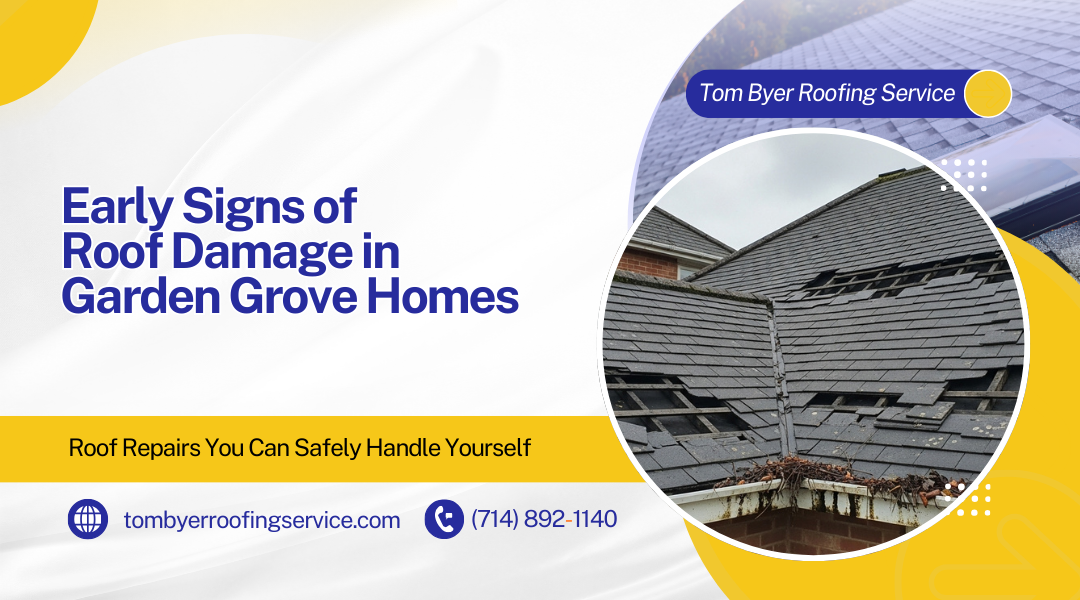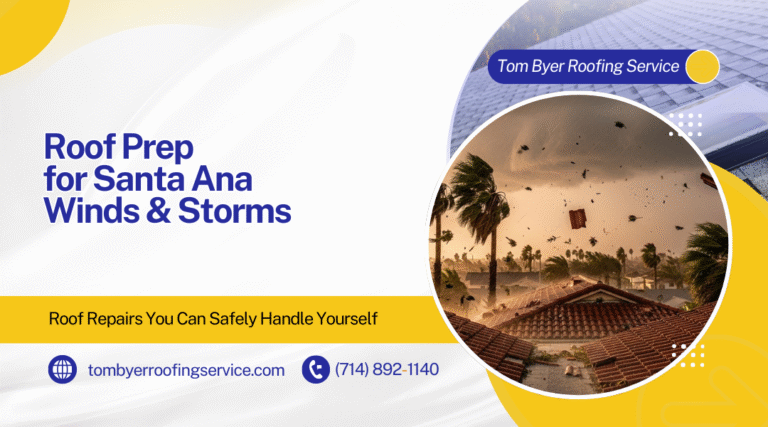Garden Grove’s older homes possess unique character and charm, but their aging roofs often harbor hidden problems that can lead to costly repairs if left undetected. Many homeowners don’t realize their roof is deteriorating until water stains appear on ceilings or shingles start falling into the yard. Learning to identify early warning signs of roof damage can save you thousands of dollars and prevent extensive interior damage to your home.
Your roof protects your most valuable asset, and recognizing trouble before it becomes a major issue requires knowing what to look for both inside and outside your home. Small leaks can go undetected for years, silently causing structural damage while you remain unaware of the problem developing above your head. The good news is that many danger signals are visible from the ground or easily spotted during routine home maintenance.
Understanding the subtle indicators that older roofs display, from exterior warning signs to interior clues, empowers you to take proactive steps before minor issues become major headaches. This guide will walk you through the specific signs to watch for, the steps to take when you notice problems, and how professional assessment can help preserve your Garden Grove home’s integrity for years to come.
Why Older Roofs in Garden Grove Require Special Attention
Aging roofs face unique challenges from material degradation over time and Garden Grove’s specific climate conditions that accelerate wear patterns. Understanding these factors helps homeowners recognize when their older roofs need immediate attention.
The Age Factor: Typical Lifespans of Common Roofing Materials
Different roofing materials have distinct lifespans that determine when problems typically emerge. Asphalt shingles last 20-25 years before showing significant wear patterns.
Clay tiles can endure 50-75 years but their underlayment deteriorates much sooner. Wood shingles typically need replacement after 25-30 years.
Metal roofing performs well for 40-70 years depending on the material type. Composition shingles begin failing around the 15-20 year mark.
Your roof’s age directly impacts its vulnerability to damage. Materials beyond their expected lifespan become brittle and lose their protective qualities.
Older roofs develop multiple weak points simultaneously. Flashing deteriorates, sealants crack, and fasteners loosen as materials age past their prime performance years.
Climate and Local Conditions That Accelerate Wear and Tear
Garden Grove’s intense UV exposure breaks down roofing materials faster than in cooler climates. The constant sunlight causes asphalt shingles to become brittle and crack.
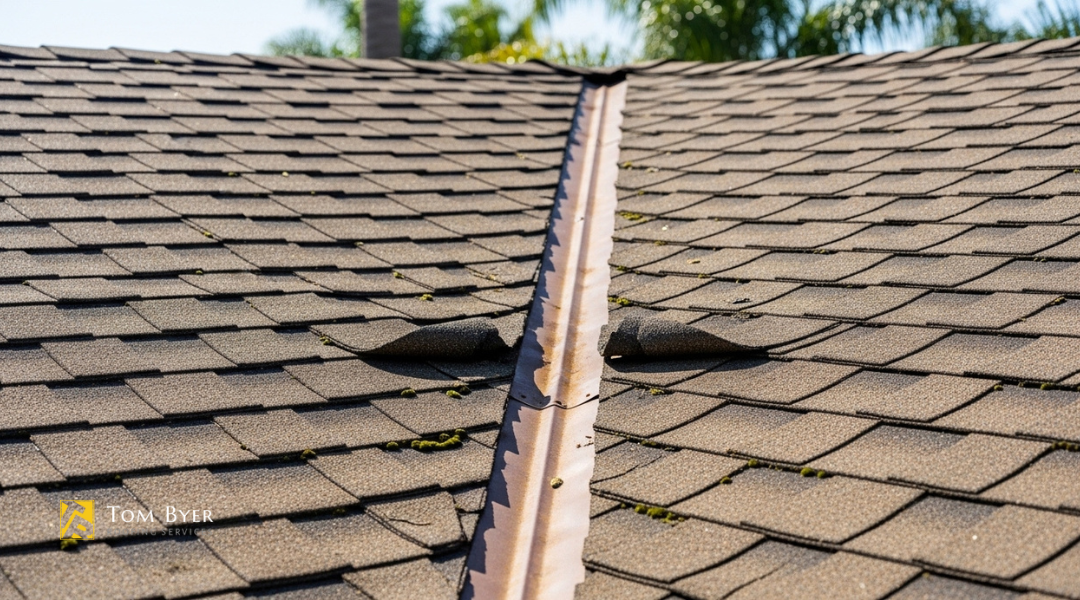
Thermal expansion from daily temperature changes creates stress on aging materials. Your roof repeatedly expands and contracts, weakening already compromised components.
Coastal moisture increases humidity levels that promote mold and mildew growth. Salt air corrodes metal components like flashing and gutters more rapidly.
Older roofing materials lack the UV-resistant additives found in modern products. This makes them particularly susceptible to California’s harsh sun exposure.
Wind patterns can lift loose or weakened shingles on older roofs. Debris from surrounding trees accumulates more easily when gutters and drainage systems show age-related deterioration.
Visual Warning Signs on the Exterior of Your Roof
Garden Grove’s older homes often show roof damage through visible exterior signs like deteriorating shingles, structural sagging, and compromised flashing systems. These warning signs typically appear gradually and require regular inspection to catch problems before they escalate.
Curling, Cracked, or Missing Shingles/Tiles
Curling shingles indicate your roof materials have reached advanced age or sustained weather damage. The edges lift upward or curl backward, exposing the underlayment to water penetration.
Cracked shingles appear as visible splits running through individual tiles or asphalt pieces. These cracks allow moisture to seep underneath, potentially causing deck rot.
Missing shingles leave obvious gaps in your roof’s protective barrier. Wind, age, or improper installation often cause entire pieces to blow off during storms.
Look for these signs during seasonal inspections:
- Granule loss in gutters and downspouts
- Blistering or bubbling on shingle surfaces
- Exposed nail heads where shingles have shifted
- Moss or algae growth in damaged areas
Damaged shingles compromise your home’s water resistance and require immediate attention to prevent interior damage.
Sagging Rooflines or Uneven Surfaces
Sagging rooflines signal serious structural problems requiring immediate professional evaluation. Your roof should maintain straight, even lines across ridges and eaves.
Visible dips or valleys in previously flat sections indicate compromised support beams or excessive weight loads. These depressions collect water and accelerate deterioration.
Uneven surfaces appear as ripples, waves, or bumps across your roofline. Poor installation, inadequate ventilation, or moisture damage often causes these irregularities.
Warning signs include:
- Drooping gutters pulling away from the roofline
- Doors and windows that stick or won’t close properly
- Interior cracks in walls or ceilings
Structural roof problems worsen rapidly and can compromise your entire home’s stability if left unaddressed.
Rust, Loose Flashing, and Damaged Chimney Seals
Rusted flashing appears as brown or orange discoloration around roof penetrations, valleys, and edges. Corroded metal loses its waterproofing ability and allows leaks.
Loose flashing pulls away from attachment points, creating gaps where water enters. Wind, thermal expansion, and age cause these critical seals to fail.
Damaged chimney seals show as cracked caulking, separated flashing, or missing mortar around the chimney base. Flashing around chimneys requires particular attention since these areas handle significant water flow.
Check these vulnerable areas:
- Step flashing along sidewalls and dormers
- Valley flashing where roof planes meet
- Drip edges along eaves and rakes
- Vent penetrations for plumbing and exhaust systems
Replace compromised flashing immediately to prevent water damage to your home’s interior structure and insulation.
Interior Clues That Signal Roof Damage
Roof damage often becomes visible inside your home before you notice problems on the exterior. Water stains, unusual odors, and unexpected light penetration serve as critical warning signs that require immediate attention.
Water Stains on Ceilings and Walls
Water stains appear as discolored patches ranging from yellow to brown on your ceilings and walls. These marks indicate active roof leaks or previous water damage that could signal ongoing problems.
Fresh water stains often feel damp to the touch and may cause paint to bubble or peel. Older stains appear as permanent discoloration with defined edges and crisp boundaries.
Common locations for water stains include:
- Areas directly below roof valleys
- Corners where walls meet ceilings
- Spaces around light fixtures or ceiling fans
- Rooms on upper floors or near chimneys
Pay attention to stains that expand during rainstorms. This indicates an active roof leak requiring immediate professional assessment.
Water damage can spread quickly through insulation and drywall. Document any new stains with photos and dates to track progression patterns.
Mold, Mildew, or Musty Smells in the Attic
Persistent moisture from roof leaks creates ideal conditions for mold growth in your attic space. A musty odor when entering your attic indicates excess humidity and potential water infiltration.
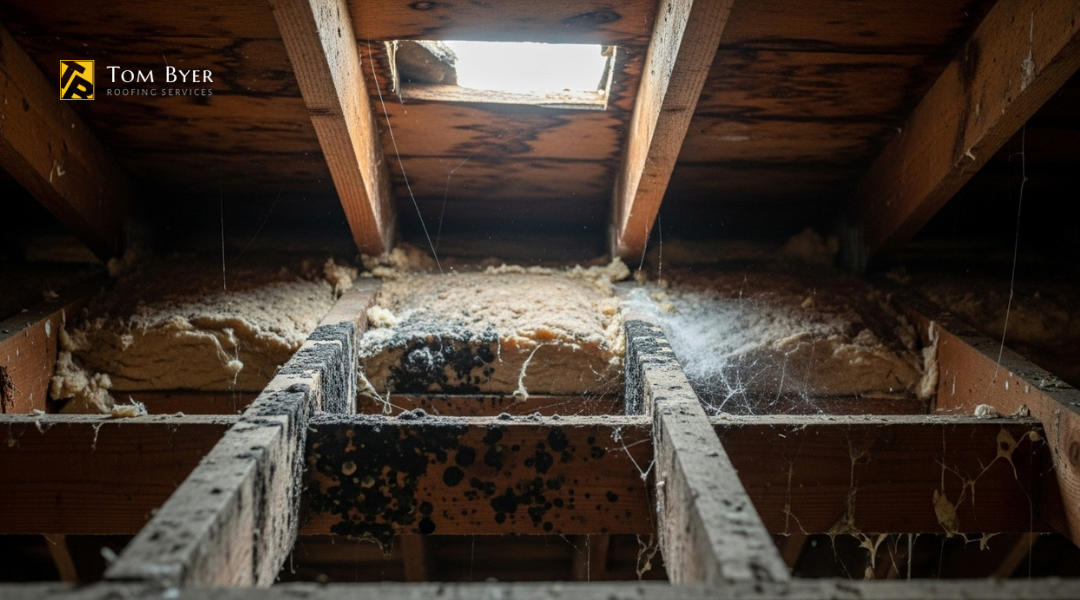
Visible mold appears as dark spots or fuzzy patches on wooden beams, insulation, or stored items. Black, green, or white discoloration on surfaces signals established mold colonies.
Health risks from attic mold include:
- Respiratory irritation
- Allergic reactions
- Worsened asthma symptoms
- Headaches and fatigue
Check your attic monthly for unusual smells or visible mold growth. Use a flashlight to inspect dark corners and areas around roof penetrations.
Professional mold remediation becomes necessary when colonies exceed small surface areas. Address the underlying roof leak before treating mold problems to prevent recurrence.
Sunlight or Drafts Coming Through the Roof
Light filtering through your roof structure indicates holes, cracks, or missing materials that compromise your home’s weather barrier. Even small openings allow water penetration during storms.
Inspect your attic during daylight hours with lights turned off. Any visible sunlight pinpoints exact locations of roof damage requiring repair.
Cold drafts in winter or hot air in summer signal gaps in your roofing system. These openings waste energy and allow moisture infiltration that leads to water damage.
Areas prone to light penetration:
- Around vent pipes and chimneys
- Ridge lines and roof peaks
- Damaged or loose shingles
- Worn flashing connections
Mark light penetration spots with chalk or tape for easy identification during repairs. Small holes can expand rapidly during weather events, making prompt attention essential.
Subtle Indicators Homeowners Often Overlook
Many Garden Grove homeowners focus on obvious damage like missing shingles or visible leaks, but the most costly problems often begin with subtle warning signs. Granule accumulation, unexpected pest activity, and gradual increases in utility costs can signal developing roof issues that require immediate attention.
Granule Loss in Gutters and Around the Home
Asphalt shingles lose granules naturally over time, but excessive granule loss indicates accelerated deterioration. You’ll notice these small, sand-like particles collecting in your gutters and downspouts after rainstorms.
Check your gutters during routine cleaning. Normal aging produces minimal granule loss, while significant accumulation suggests weathering damage or manufacturing defects.
Look for granules around your home’s foundation after heavy rain or wind. Garden Grove’s occasional Santa Ana winds can accelerate this process on older roofs.
Bare spots on shingles become visible when granule loss becomes severe. These exposed areas allow UV rays to deteriorate the underlying asphalt layer more rapidly.
Heavy granule loss often occurs after:
- Hailstorms
- Extreme temperature fluctuations
- Installation of new gutters or roof equipment
- Foot traffic during maintenance
Document granule accumulation with photos during seasonal gutter cleaning. Sudden increases in granule loss warrant professional inspection, especially on roofs over 15 years old.
Persistent Pests or Birds Nesting in Roof Gaps
Birds and small animals seeking shelter often discover roof vulnerabilities before homeowners notice them. Persistent nesting activity indicates gaps in roofing materials or damaged fascia boards.
Pay attention to increased bird activity around specific roof areas. Squirrels, raccoons, and birds exploit loose shingles, damaged vents, or deteriorated flashing to access attic spaces.
Common entry points include:
- Damaged roof vents
- Loose ridge caps
- Gaps around chimneys
- Deteriorated soffit areas
Listen for scratching or movement sounds in your attic, particularly during early morning or evening hours. These sounds often indicate successful pest entry through compromised roof areas.
Nesting materials like twigs, leaves, or insulation scattered around your property suggest animals are accessing your roof structure. Fresh droppings near roof lines also indicate active pest problems.
Address pest activity immediately. Animals can cause significant damage by enlarging small gaps and creating multiple entry points throughout your roofing system.
Rising Energy Bills from Poor Insulation and Ventilation
Unexplained increases in heating and cooling costs often signal roof-related efficiency problems. Damaged roofing allows conditioned air to escape while letting outdoor air infiltrate your home.
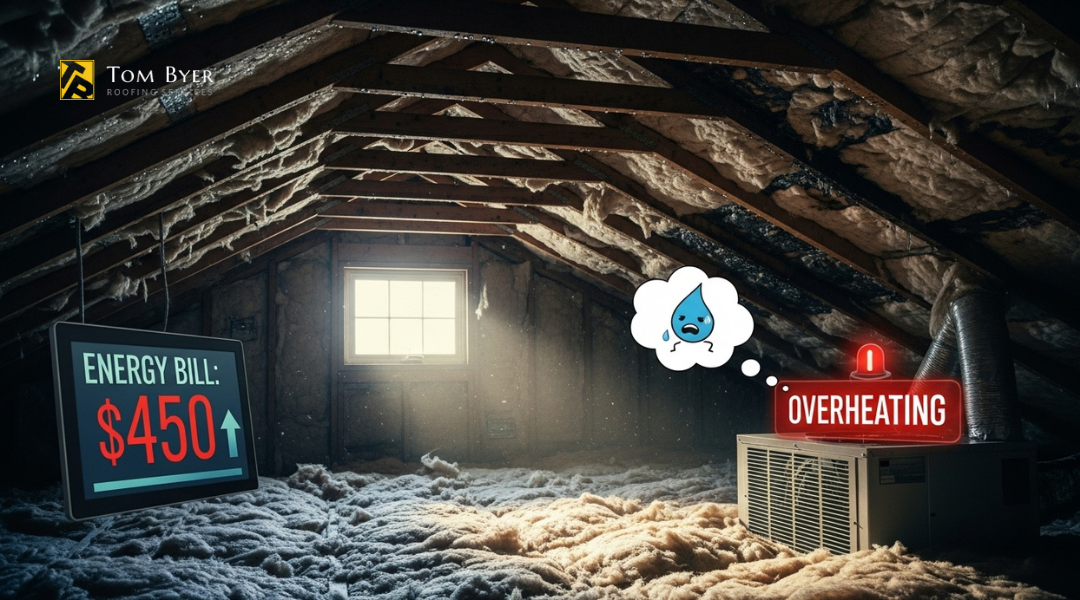
Compare your energy bills from the same months in previous years. Increases of 10-15% or more without changes in usage patterns may indicate roof problems affecting your home’s thermal envelope.
Poor attic ventilation creates temperature imbalances that force your HVAC system to work harder. Inadequate airflow also allows moisture buildup that can damage insulation effectiveness.
Signs of ventilation problems include:
- Ice dams in winter
- Excessive attic heat in summer
- Moisture or frost in attic spaces
- Premature aging of roofing materials
Monitor indoor humidity levels during seasonal transitions. High humidity despite normal weather patterns suggests ventilation issues that compromise both comfort and energy efficiency.
Professional energy audits can identify specific areas where roof damage contributes to efficiency losses, helping prioritize repair needs based on actual cost impact.
Steps to Take When You Notice Early Roof Damage
Taking immediate action when you spot roof damage can prevent minor issues from becoming major structural problems. Proper documentation, knowing when professional help is required, and preparing for potential insurance claims are essential steps that protect both your home and wallet.
Documenting and Monitoring the Problem
Start by taking clear photographs of the damage from multiple angles. Use your smartphone to capture close-up shots and wider views that show the damage in context with surrounding areas.
Record the date and time of discovery in a notebook or digital file. Note weather conditions that may have contributed to the damage, such as recent storms, high winds, or hail.
Essential documentation includes:
- Photos of damaged shingles, flashing, or gutters
- Interior water stains or ceiling damage
- Measurements of affected areas
- Written descriptions of what you observed
Monitor the damage regularly, especially after rain or wind events. Check interior spaces below the damaged area for new water stains or signs of moisture.
Keep all documentation organized in one location. This information becomes crucial when contacting roofing contractors or filing insurance claims.
When to Call a Professional vs. Temporary DIY Solutions
Contact a roofing professional immediately for structural issues like sagging, extensive shingle loss, or active leaks. These problems require specialized expertise and can worsen rapidly.
Call professionals for:
- Missing or loose flashing around chimneys or vents
- Multiple damaged or missing shingles
- Visible roof deck damage
- Any safety concerns during inspection
Safe temporary measures include placing tarps over small areas during storms or positioning buckets to catch dripping water. Only attempt these solutions if you can do so safely from ground level or through attic access.
Avoid walking on wet or damaged roofing materials. Never attempt repairs during adverse weather conditions or if you feel uncertain about your safety.
Minor gutter cleaning or removing small debris may be manageable DIY tasks for some homeowners. However, any work involving heights or structural elements should be left to professionals.
Preparing for Insurance or HOA Involvement if Needed
Review your homeowner’s insurance policy to understand coverage limits and deductibles before filing claims. Look for specific language about roof damage, age restrictions, and covered perils.
Contact your insurance company promptly to report damage. Many policies require notification within a specific timeframe after discovering problems.
Gather required information:
- Policy number and coverage details
- Detailed damage documentation
- Repair estimates from licensed contractors
- Receipts for emergency repairs or materials
If you live in a community with an HOA, notify them of visible exterior damage. Some associations have specific requirements for roofing materials, colors, or approval processes for repairs.
Schedule professional inspections before filing formal claims. Insurance adjusters often require contractor estimates to process claims efficiently.
Keep detailed records of all communications with insurance representatives and HOA officials. Document claim numbers, adjuster names, and scheduled inspection dates for future reference.
How Tom Byer Roofing Service Helps Older Homes in Garden Grove
Tom Byer Roofing Service brings over 60 years of experience to Garden Grove’s aging residential properties, offering specialized inspections that identify age-related deterioration, customized repair solutions for older construction methods, and maintenance programs designed to maximize remaining roof lifespan.
Comprehensive Roof Inspections for Aging Properties
Your older Garden Grove home requires specialized attention during roof inspections. Tom Byer Roofing Service understands the unique challenges that homes built decades ago present.
Inspection Focus Areas:
- Original materials from the 1950s-1980s that may contain outdated components
- Structural integrity of aging wooden frames and supports
- Weather damage accumulated over multiple decades of Southern California sun exposure
The company’s technicians examine areas where older homes commonly develop problems. These include deteriorated flashing around chimneys and vents, worn composition shingles, and compromised underlayment.
Professional roof inspection services identify issues before they become expensive repairs. The team uses advanced tracking methods to locate hidden leaks that don’t always appear directly above interior water damage.
Tom Byer’s inspectors document findings with detailed reports. You receive photographs and explanations of problem areas, helping you understand your roof’s current condition and prioritize necessary repairs.
Repair and Replacement Options Tailored to Older Structures
Older Garden Grove homes often feature construction methods and materials no longer used today. Tom Byer Roofing Service adapts repair strategies to work with these legacy building techniques.
Specialized Services Include:
- Matching discontinued roofing materials when possible
- Reinforcing aging structural elements during repairs
- Installing modern materials that integrate with older roof systems
Your home may have original clay tiles, wood shingles, or early composition materials. The company’s experience spans multiple decades of roofing evolution, allowing technicians to work effectively with any material type.
Termite damage frequently affects older roofs in Southern California. Tom Byer provides comprehensive solutions for termite-weakened structures, from limited spot repairs to extensive restoration work.
The team evaluates whether repairs or full replacement better serves your needs. They explain their recommendations clearly, helping you make informed decisions about your older home’s roofing investment.
Preventative Maintenance Plans to Extend Roof Lifespan
Regular maintenance becomes crucial as your Garden Grove home ages. Tom Byer Roofing Service offers proactive maintenance programs specifically designed for older properties.
Maintenance Components:
- Semi-annual inspections to catch developing problems early
- Cleaning and debris removal from gutters and roof surfaces
- Preventative repairs to extend existing materials’ lifespan
Your older roof benefits from consistent professional attention. Small issues like loose shingles or minor flashing problems can be addressed before they allow water infiltration.
The maintenance approach focuses on maximizing your current roof’s remaining useful life. This strategy often proves more cost-effective than waiting for major failures that require emergency repairs.
Seasonal maintenance schedules account for Garden Grove’s weather patterns. The company times inspections and repairs around the area’s typical storm seasons to ensure your older home stays protected year-round.

